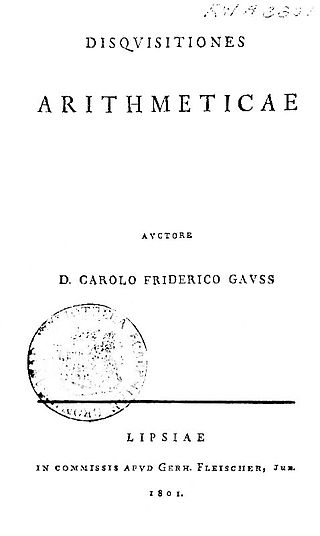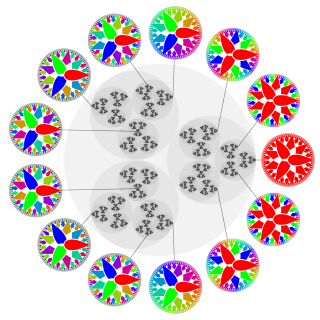
In mathematics, the Chinese remainder theorem states that if one knows the remainders of the Euclidean division of an integer n by several integers, then one can determine uniquely the remainder of the division of n by the product of these integers, under the condition that the divisors are pairwise coprime.
In number theory, the Legendre symbol is a multiplicative function with values 1, −1, 0 that is a quadratic character modulo of an odd prime number p: its value at a (nonzero) quadratic residue mod p is 1 and at a non-quadratic residue (non-residue) is −1. Its value at zero is 0.

In number theory, the law of quadratic reciprocity is a theorem about modular arithmetic that gives conditions for the solvability of quadratic equations modulo prime numbers. Due to its subtlety, it has many formulations, but the most standard statement is:

In number theory, given a prime number p, the p-adic numbers form an extension of the rational numbers which is distinct from the real numbers, though with some similar properties; p-adic numbers can be written in a form similar to decimals, but with digits based on a prime number p rather than ten, and extending to the left rather than to the right. Formally, given a prime number p, a p-adic number can be defined as a series
The Jacobi symbol is a generalization of the Legendre symbol. Introduced by Jacobi in 1837, it is of theoretical interest in modular arithmetic and other branches of number theory, but its main use is in computational number theory, especially primality testing and integer factorization; these in turn are important in cryptography.
In number theory, Euler's criterion is a formula for determining whether an integer is a quadratic residue modulo a prime. Precisely,
In modular arithmetic, a number g is a primitive root modulo n if every number a coprime to n is congruent to a power of g modulo n. That is, g is a primitive root modulo n if for every integer a coprime to n, there is some integer k for which gk ≡ a. Such a value k is called the index or discrete logarithm of a to the base g modulo n. So g is a primitive root modulo n if and only if g is a generator of the multiplicative group of integers modulo n.
In number theory, an integer q is called a quadratic residue modulo n if it is congruent to a perfect square modulo n; i.e., if there exists an integer x such that:
In number theory, quadratic Gauss sums are certain finite sums of roots of unity. A quadratic Gauss sum can be interpreted as a linear combination of the values of the complex exponential function with coefficients given by a quadratic character; for a general character, one obtains a more general Gauss sum. These objects are named after Carl Friedrich Gauss, who studied them extensively and applied them to quadratic, cubic, and biquadratic reciprocity laws.
In number theory, the Kronecker symbol, written as or , is a generalization of the Jacobi symbol to all integers . It was introduced by Leopold Kronecker.
Gauss's lemma in number theory gives a condition for an integer to be a quadratic residue. Although it is not useful computationally, it has theoretical significance, being involved in some proofs of quadratic reciprocity.
The Goldwasser–Micali (GM) cryptosystem is an asymmetric key encryption algorithm developed by Shafi Goldwasser and Silvio Micali in 1982. GM has the distinction of being the first probabilistic public-key encryption scheme which is provably secure under standard cryptographic assumptions. However, it is not an efficient cryptosystem, as ciphertexts may be several hundred times larger than the initial plaintext. To prove the security properties of the cryptosystem, Goldwasser and Micali proposed the widely used definition of semantic security.
In number theory, the law of quadratic reciprocity, like the Pythagorean theorem, has lent itself to an unusually large number of proofs. Several hundred proofs of the law of quadratic reciprocity have been published.
The Tonelli–Shanks algorithm is used in modular arithmetic to solve for r in a congruence of the form r2 ≡ n, where p is a prime: that is, to find a square root of n modulo p.
In cryptography, most public key cryptosystems are founded on problems that are believed to be intractable. The higher residuosity problem is one such problem. This problem is easier to solve than integer factorization, so the assumption that this problem is hard to solve is stronger than the assumption that integer factorization is hard.
Cubic reciprocity is a collection of theorems in elementary and algebraic number theory that state conditions under which the congruence x3 ≡ p (mod q) is solvable; the word "reciprocity" comes from the form of the main theorem, which states that if p and q are primary numbers in the ring of Eisenstein integers, both coprime to 3, the congruence x3 ≡ p is solvable if and only if x3 ≡ q is solvable.
Cocks IBE scheme is an identity based encryption system proposed by Clifford Cocks in 2001. The security of the scheme is based on the hardness of the quadratic residuosity problem.
Quartic or biquadratic reciprocity is a collection of theorems in elementary and algebraic number theory that state conditions under which the congruence x4 ≡ p is solvable; the word "reciprocity" comes from the form of some of these theorems, in that they relate the solvability of the congruence x4 ≡ p to that of x4 ≡ q.
The decisional composite residuosity assumption (DCRA) is a mathematical assumption used in cryptography. In particular, the assumption is used in the proof of the Paillier cryptosystem.
In mathematics, elliptic curve primality testing techniques, or elliptic curve primality proving (ECPP), are among the quickest and most widely used methods in primality proving. It is an idea put forward by Shafi Goldwasser and Joe Kilian in 1986 and turned into an algorithm by A. O. L. Atkin the same year. The algorithm was altered and improved by several collaborators subsequently, and notably by Atkin and François Morain, in 1993. The concept of using elliptic curves in factorization had been developed by H. W. Lenstra in 1985, and the implications for its use in primality testing followed quickly.































